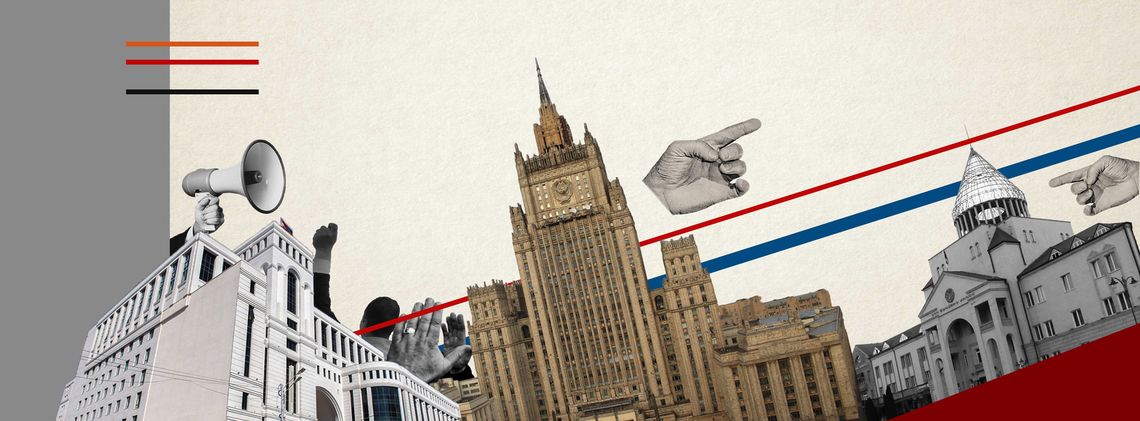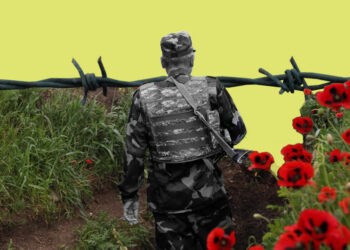

Russia’s Self-Interested Mediation
On April 21, 2020, Russian Foreign Affairs Minister Sergey Lavrov referred to a “step-by-step” approach to resolving the Nagorno Karabakh conflict, which would involve withdrawal of Armenian troops from territories beyond the Soviet-era borders of the Nagorno Karabakh Autonomous Oblast in exchange for a lifting of the economic blockade by Azerbaijan. This statement was highly unprofessional.
Best practices in third-party mediation require a modicum of neutrality on the side of the mediator, even if the mediator is a neighbor with its own geopolitical interests. However, the suggested intermediate steps would be a great setback for the Armenian side’s negotiating position, requiring only easily-reversible concessions from Azerbaijan. It is not clear whether the statement was directed from the Kremlin or was a result of Lavrov’s own initiative but convention would suggest that announcements on such a delicate issue would first require the Kremlin’s approval. In either case, it reflected Russia’s centuries-old imperial instincts of using divide-and-conquer tactics on its periphery. Again, best practices and studies in third-party mediation have shown that neutrality is an important albeit an aspired value, which provides space for the conflict parties to arrive at a solution on their own. Sharing conversations or engaging in the outright falsification or distortion of the diplomatic record from the meetings without the parties’ agreement has no value in moving the peace process forward. Instead, it only obstructs it.
Most importantly, Lavrov himself has done little toward building local capacities for peace processes, which would entail people-to-people contacts and civil society engagement. Both of these are threatening for authoritarian leaders, be it Russia or Azerbaijan. Russia’s centuries-old traditional practice of building security in its periphery has been one of top-down and politically engineered external interventions, often coercive ones. Russia lacks any tradition of enabling bottom-up and participatory processes of peacebuilding. Furthermore, there are serious doubts that Russia, an interested party in the conflict acting in a mediator role, would try to create any political space or incentives for the conflict parties to move forward on the peace process on their own. Russia does have instruments to constrain the parties, but only up to a limit. However, it realizes that a diplomatic breakthrough would weaken its position in this conflict and, consequently, in the region.
It is in the interest of citizens in Armenia, Azerbaijan and Artsakh to build local capacities and direct channels of conflict management and resolution, beyond the Nagorno Karabakh conflict. The absence of regional structures of conflict management in the South Caucasus makes the region vulnerable to great power intervention, which has usually been destructive.
In terms of content, the “step-by-step” or “package” solutions have always been on the table, along with probably numerous other scenarios. Successive Armenian governments have not committed to any one plan, and even the Madrid Principles remain just that, guiding principles subject to detailed negotiation. With his statement, it appears that Lavrov tried to tip the balance in favor of Azerbaijan at this point, but creating uncertainty may be another objective he pursued. Indeed, Russia hopes to entice Azerbaijan more firmly into its orbit, but this does not entail dropping Armenia as an “ally.” For Azerbaijan, any closer “alliance” with Russia would come at a significant cost to their government if it reduces flexibility in managing energy reserves and their associated transportation routes. Overall, though, Russia does not, and will not, openly commit to any one conflict party in this case, as it would reduce its influence over the region. Preventing Russia from placing its troops in and around Nagorno Karabakh in a peacekeeping capacity should be an aim, but this requires much closer coordination and more intense negotiations between Armenia and Azerbaijan, which seems unlikely at the moment.
The Velvet Factor
There are several factors which are conducive to a peaceful resolution of the conflict, as well as a range of challenges to that end. This is a conflict with a ceasefire agreement which is monitored and implemented with very little third-party presence on the ground. Despite recurrent ceasefire violations and the 2016 Four Day April War, the parties seem to have accepted the fragile political stability surrounding the conflict over the past few decades. The most transformative development for the Nagorno Karabakh conflict to date has been Armenia’s Velvet Revolution, because it shifted the source of governmental legitimacy in Armenia away from the external support of Russian and European capitals, and back to the Armenian people. Despite significant shortcomings, democratic practices and habits in Nagorno Karabakh/Artsakh also continue to prevail, evident in its record of consistently free and fair elections. Armenia’s democratic transition has strengthened the “democratic pole” in the South Caucasus; there is now a “democratic dyad” with neighboring Georgia, as well as an obvious divergence from Azerbaijan’s clan- or family-based form of authoritarian rule. Studies of other parts of the world, for example, demonstrate that, in regions with stronger democratic poles, the costs of military and coercive approaches to settling conflicts, such as those voiced and practiced by Azerbaijan, increase dramatically. This is very important.
The new discourse rhetoric coming from the government in Armenia toward more participatory forms of peace processes are welcome outcomes of the Velvet Revolution. Whether advocating for the return of Artsakh’s representatives to the negotiation table, or adopting a welcome new consideration of the interests of the Azerbaijani people, these “Velvet effects” are moving the peace process in the right direction. Studies and best practices from other effective peace processes highlight the importance of inclusivity of parties, as well as the local capacity in building and sustaining peaceful conflict resolution practices in conflict regions. An essential next step in this direction is the inclusion of women, who are already active at local levels of cross-border engagement. As I have argued elsewhere, the inclusion of women in peace processes in Nagorno Karabakh is overdue, and supported by peacebuilding practices around the world.
At the same time, existing “authoritarian reserves” in Armenia (i.e. vestiges of the prior authoritarian period and their progeny, such as certain right-wing movements and broadcast media) have sought to leverage the Nagorno Karabakh conflict into an instrument with which to politically challenge and pressure the current government. This is not only an opportunistic attempt at targeting the perceived “weakness” of the Pashinyan government, but is also a more dangerous cleavage that offers a strategic opening for the Kremlin, as seen in Lavrov’s most recent statement, to wield that cleavage against the Armenian government. In short, the fragility and still-developing nature of democratic institutions in Armenia has significant strategic consequences for the Nagorno Karabakh peace process.
To date, however, the values of the Velvet Revolution could have been used much more strategically in shaping the discourse around the Nagorno Karabakh conflict. There has been relatively little attempt to use the language of non-violence as an element of strategy in the negotiations. Of course, this is a weak point for the Aliyev regime (although not the Azerbaijani people), which continues to rely on the Nagorno Karabakh conflict to shore up its meager legitimacy and increasingly tenuous grip on the country. To infuse “Velvet values” into the Nagorno Karabakh peace process necessitates treating the Aliyev regime as an actor separate from the Azerbaijani people. In tactical terms, this requires creating and using forums of public diplomacy to reach out to the people of Azerbaijan. However, this may be a direction that the Pashinyan government may not wish to take. Still, working in tandem with Georgia, the Armenian government can and should become a proactive advocate for non-violence and its strategic superiority in building regional security systems in the South Caucasus.
Limits to OSCE Minsk Group Facilitation
Statements by the Co-Chairs of the OSCE Minsk Group, which includes the United States and France along with Russia, often refer to “preparing populations for peace.” The phrase is used to encompass quite a broad concept. Internally for each side, it entails public discourse on the costs of war, the types of conflict outcomes (peace settlement versus victory consolidation), the shape of a peaceful settlement, contours and dividends of peaceful coexistence, etc. In a “hard” authoritarian country like Azerbaijan, this is hardly possible. Some of the drivers of anti-Armenian attitudes are symptoms and manifestations of Azerbaijani authoritarianism.
Voices from the broader spectrum of society are silenced or marginal at best. Civil society groups are crushed, and racism and xenophobia are harnessed by the state. The possibility of discourse in this context may be distant. In Armenia, too, however, the public attitude remains polarized. The peacebuilding community active in the country enjoys marginal political space, even with this democratic government. Compromise seems to still be a “dirty word” in the public discourse. Lacking people-to-people contacts, attitudes hostile to the other party are bound to continue. But the anti-Armenian attitudes in Azerbaijan are of a qualitatively different and more destructive nature. They are used and deployed for purposes of regime survival, and they have an insidious effect on Azerbaijani society, the young generation, and the chances for democratization in the future. Azerbaijan need look no further than to its ally Turkey, where xenophobia and genocide denial have paved the way for deepening authoritarianism.
The Minsk Group Co-Chairs can be helpful in setting guardrails, or at least articulating key principles, toward maintaining civilized discourse. They do need to provide political support for creating ceasefire violation monitoring systems. The occasional exchange of journalists and filmmakers, while hugely important, has been insufficient to date. Mechanisms to scale up such encounters are necessary to de-escalate the situation. Taking war off the table in the region is a prerequisite for strengthening the sovereignty of each state. Otherwise, the region will continue to be another marketplace for lucrative global arms trades and remain perpetually vulnerable to great power intervention.
In the post-pandemic world, the OSCE Minsk Co-Chairs need to broaden their attention to building regional structures of engagement in the South Caucasus. The societies around the Nagorno Karabakh conflict are not ready for a settlement, and a peace settlement is not likely to emerge in this context of deep political tension between them, with hardly any contact between the societies. It is in the interests of the Western world to see strong regional capacities of engagement in the South Caucasus, as the Western powers are showing a decline in political appetite for remaining engaged. Many conflict regions will need to learn to take care of themselves. The states in the region should be taking the lead in negotiating their own futures. For Russia, perhaps contrary to the more traditional policies practiced by the Kremlin, a more coherent and regionally-connected South Caucasus would only add to Russia’s connectivity in Eurasia. Many empires have fallen because of their fractured peripheries. Russia should take note.
Keeping War Off the Table
War is never inevitable. People always have a choice. The possibility of war resumption is a question which needs to be viewed separately for the Aliyev regime, and in terms of possible broader structural factors that can lead to it. For the Aliyev regime, the resumption of war in the midst of a pandemic, declining oil revenue and economic stress in the country would be a big gamble. Starting wars when a state is already internally challenged by a public health crisis is hardly conducive to an authoritarian regime’s survival, even if distracting the public’s attention from domestic problems is the underlying motivation. Studies have shown that war resumption may generate a temporary “rally around the flag” effect but such effects dissipate quickly when the population eventually realizes its costs. Inside Azerbaijan, in the context of a pandemic, such a mass mobilization can easily be turned against the Aliyev regime itself.
This exact scenario played out in Armenia when Serzh Sargsyan’s government experienced increased public support during the 2016 Four Day April War, but shortly thereafter, the public started asking questions about war losses and corruption, which exploded in the public discourse, eventually culminating in his forced resignation in 2018.
Indeed, for President Aliyev, war resumption is particularly risky at this time. As elsewhere around the world, the Azerbaijani state is being strained in its administrative capacity by the public health crisis created by the pandemic. Therefore, any public mobilization for a war effort will be hard to control at this time, and the war will only exacerbate the economic situation in the country. For Armenia, resumption of war would of course also be costly. The government is still undergoing a democratic consolidation process, with reforms in the judiciary still delayed. The Armenian Ministry of Foreign Affairs has been clear in supporting and affirming the value of peaceful negotiations, but it can be more specific and deliberate in communicating the costs of war for the people of Armenia, Artsakh and also Azerbaijan. Continuing to call out the Aliyev regime for breaking the ceasefire conditions and failing to deepen the ceasefire regime are important, but these messages remain rather defensive.
Nagorno Karabakh/Artsakh Deserves to Decide Its Own Fate
What has been characteristic of the ongoing peace process is the assumption that a “big bang” peace settlement, the magic formula, will be found one day, and everyone will live happily ever after. Any peace settlement requires years of work in diffusing tensions in conflict societies. Relaxation of tensions tends to precede peace settlements. Even if a peace settlement is agreed to, its implementation requires the support of the conflict parties. Therefore, the direct inclusion of Artsakh representatives in producing and implementing a peace settlement is overdue. Such basic inclusivity is supported by peacebuilding theory and practice. Only a minority of peace agreements throughout history are ever actually implemented, and most tend to break down within a few years. The fundamental failure to include all of the conflict parties in negotiations is a major factor in the failure of peace agreement implementation.
Moreover, peaceful settlements, strategically important for the region and for all conflict societies, tend to be messy and divisive. Their formulation and implementation, especially given the concessions involved in any possible settlement, require broad, open and inclusive discussions within societies. Issues such as the political and economic costs of the resumption of hostilities, the social impacts of the war, and the advantages and disadvantages of a negotiated settlement relative to conflict termination through military means all need to be debated and discussed with the people.
The inclusion of Artsakh is also critical in the building of parallel channels of consultation with civil society groups on all sides. There are peacebuilding organizations across this conflict divide whose work does not receive the attention it deserves. This work is usually carried out quietly, with little contact and coordination with governmental negotiations. And groups working in peacebuilding programs in Azerbaijan are regularly harassed. Stories of coexistence and cooperation between Armenians and Azerbaijanis are as old as the ones of inter-ethnic clashes between them. More civil society contact is essential for all of these narratives to emerge.
Editor’s Note: Following the 2017 Constitutional Referendum, the name of the Nagorno Karabakh Republic became the Republic of Artsakh. When referring to the conflict resolution process, EVN Report uses the term Nagorno Karabakh, which is also included in the Constitution of Artsakh.
also read
The Liberation of Shushi: A Turning Point on Many Fronts
The liberation of the strategic town of Shushi was a turning point in the Karabakh war, causing a dramatic shift in the military progress of Armenian forces and ultimately obstructing future Turkish-Armenian relations.
Read moreThe Incoherence of Peace: The Karabakh Quagmire and the Fine Line Between Compromise and Capitulation
While taking the reader through the complexities of international law, Dr. Nerses Kopalyan writes that when Armenia and Azerbaijan speak about peace, they mean completely different things. What they are actually saying is that they seek peace on their own terms.
Read moreTaking Up the Challenge of Peace
Deputy Foreign Affairs Minister of Artsakh, Armine Aleksanyan on her long journey from Martouni to Stepanakert, to London and Vienna and back to Artsakh to work in the service of a country that is not recognized by the world.
Read morefrom out archives
Consequences of the Velvet Revolution – From Local to Global
Dr. Anna Ohanyan, Richard B. Finnegan Distinguished Professor of Political Science and International Relations at Stonehill College is EVN Report’s guest for a Live Facebook conversation. The discussion will focus on the Consequences of the Velvet Revolution – From Local to Global.




